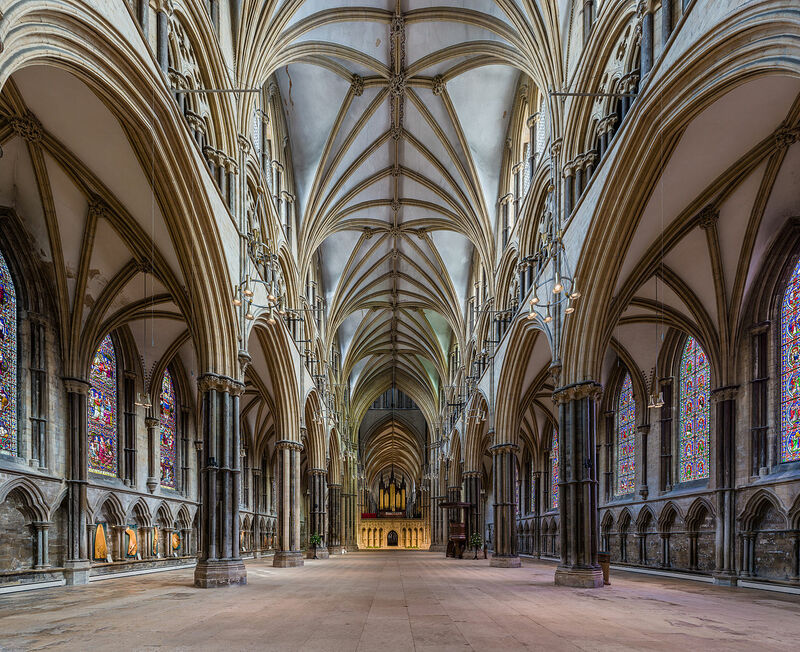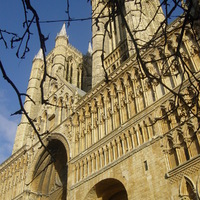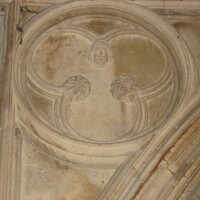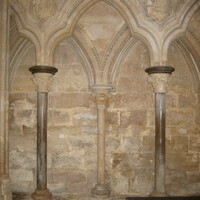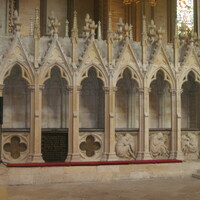Lincoln Cathedral
Type:
Churches
Date:
Twelfth and thirteenth centuries; fourteenth-century Easter Sepulcher
Location or Findspot (Modern-Day Country):
United Kingdom
Description:
Although Lincoln Cathedral was begun in 1072, it had to be rebuilt and expanded over several phases, often in response to disasters (e.g., a fire that destroyed the timber roof in 1141, a major earthquake in 1185). The choir, associated with Bishop Hugh of Avalon (later known as St. Hugh of Lincoln) was rebuilt beginning in 1192. Keeping the roof in place are wooden trusses designed as triangles within triangles. The vaults in the choir, sometimes called "crazy vaults," are notably asymmetrical.
The slightly later nave (ca. 1220–35) does not have such asymmetrical vaults and is almost 3 metres (10 feet) higher than St. Hugh's choir. It allows a great deal more light to enter the space through the lancet windows in the clerestory.
Lincoln Cathedral is well known for its Angel Choir (1256–80), which is east of St. Hugh's choir and was built to accommodate the shrine housing Hugh's remains. Its name is a reference to the musician angels in the spandrels. Certain piers in this choir are made entirely of Purbeck marble. Purbeck, which is actually a polished limestone and not a marble, has a brownish-grey color that creates a visual contrast when set against the limestone used in other parts of the cathedral.
The cathedral's fourteenth-century Easter Sepulcher belongs to a new practice, beginning in the late thirteenth century, of creating life-size replicas of Christ's tombs. The Lincoln example includes the three guards who have fallen asleep while guarding Christ's body from his followers (Matt. 27:65–66).
The slightly later nave (ca. 1220–35) does not have such asymmetrical vaults and is almost 3 metres (10 feet) higher than St. Hugh's choir. It allows a great deal more light to enter the space through the lancet windows in the clerestory.
Lincoln Cathedral is well known for its Angel Choir (1256–80), which is east of St. Hugh's choir and was built to accommodate the shrine housing Hugh's remains. Its name is a reference to the musician angels in the spandrels. Certain piers in this choir are made entirely of Purbeck marble. Purbeck, which is actually a polished limestone and not a marble, has a brownish-grey color that creates a visual contrast when set against the limestone used in other parts of the cathedral.
The cathedral's fourteenth-century Easter Sepulcher belongs to a new practice, beginning in the late thirteenth century, of creating life-size replicas of Christ's tombs. The Lincoln example includes the three guards who have fallen asleep while guarding Christ's body from his followers (Matt. 27:65–66).
Relevant Textbook Chapter(s):
Introduction,
7,
8,
9
Repository and Online Resources:
• Watch a video on Lincoln Cathedral posted at Smarthistory (with narration from Dr. Beth Harris and Dr. Steven Zucker).
• See a 3D model of the "crazy vaults."
Image Credits:
Wikimedia Commons,
Jill Caskey
